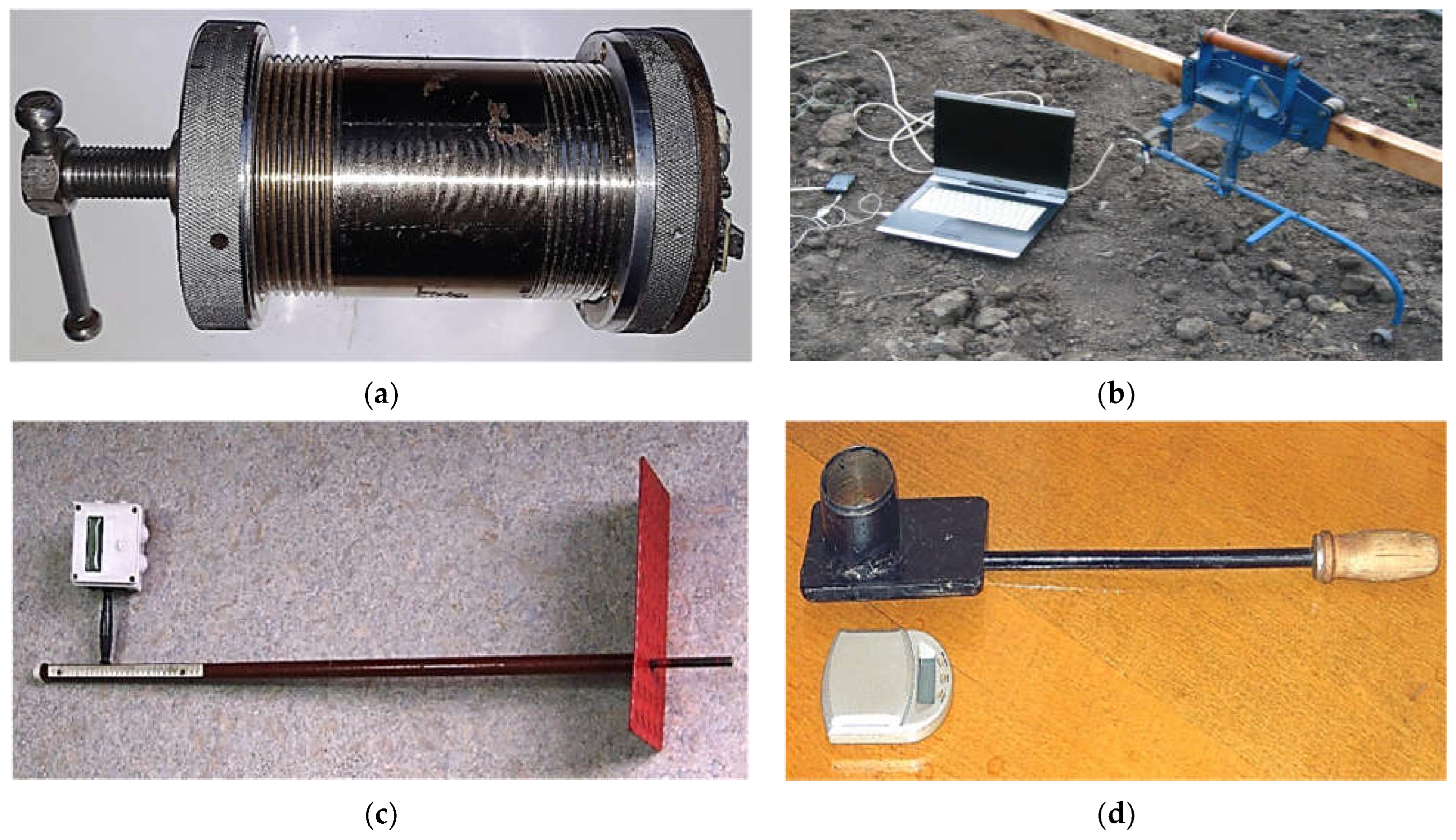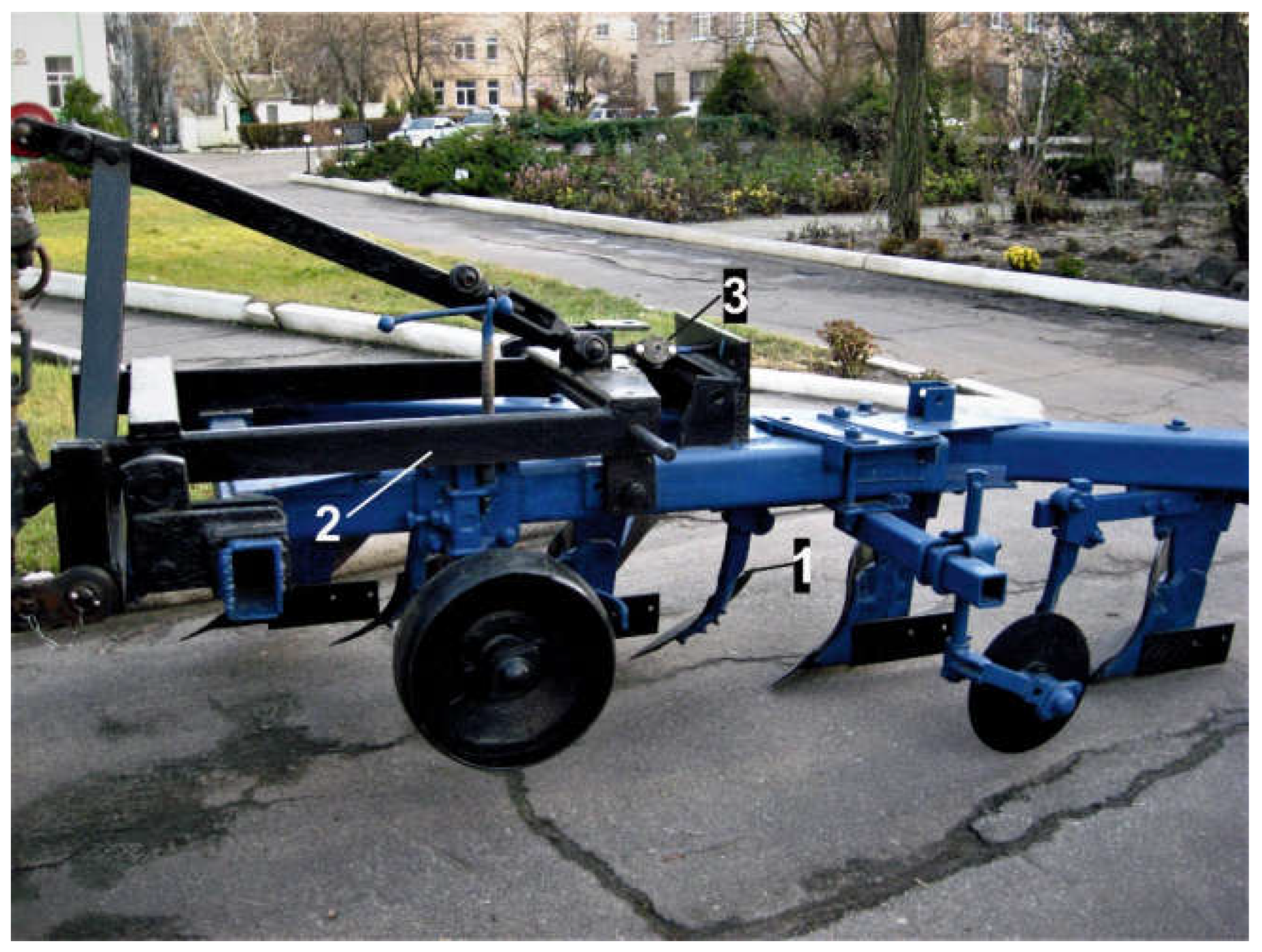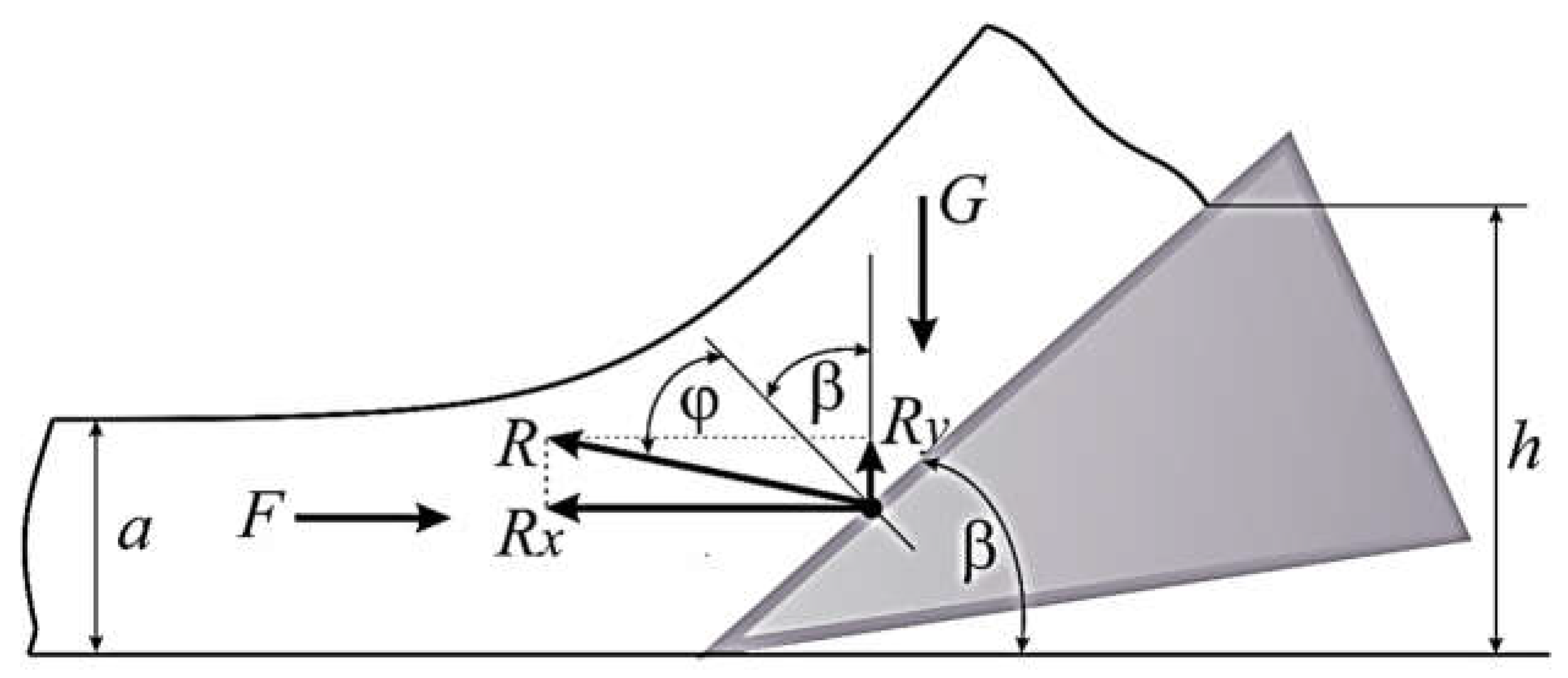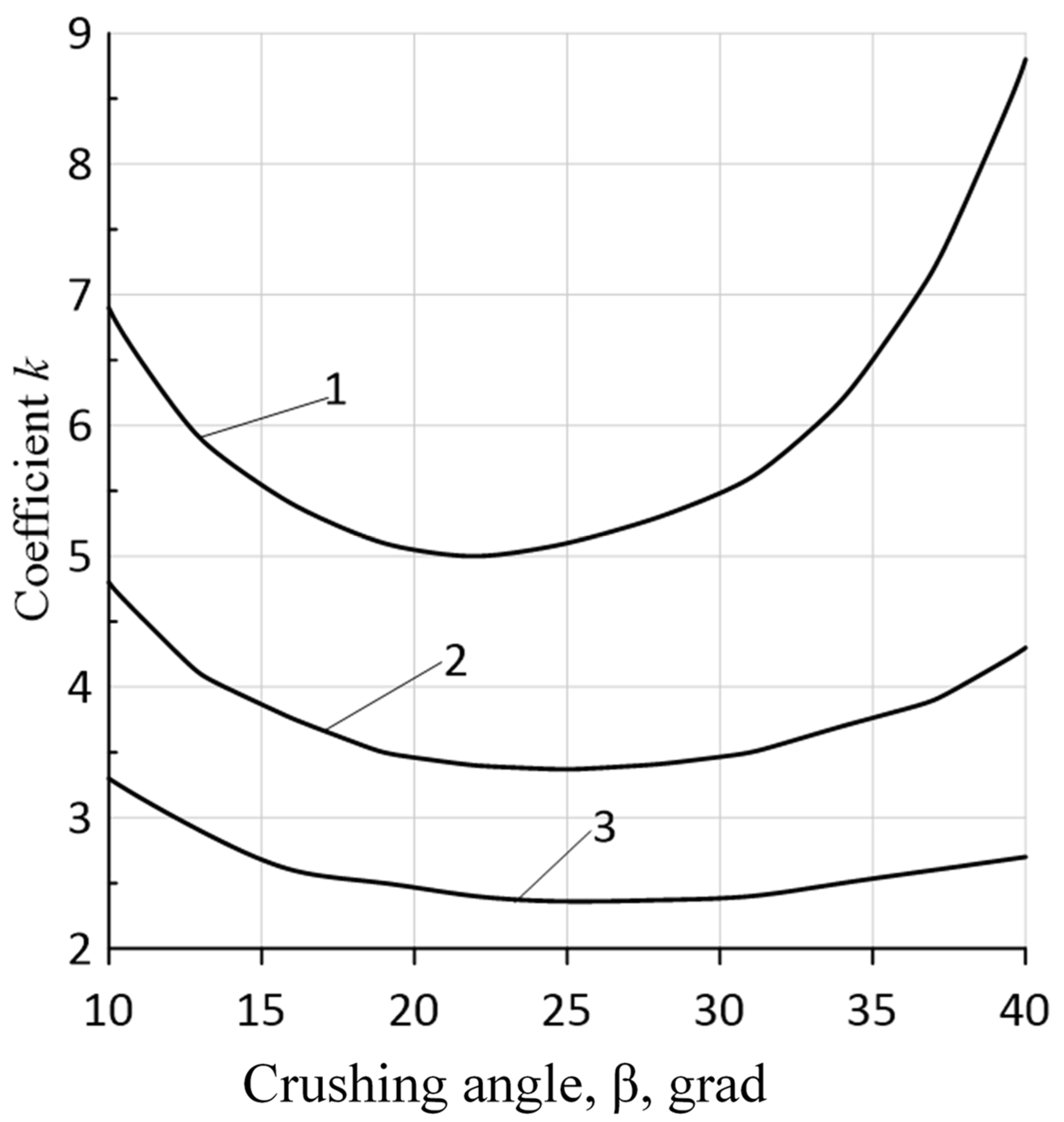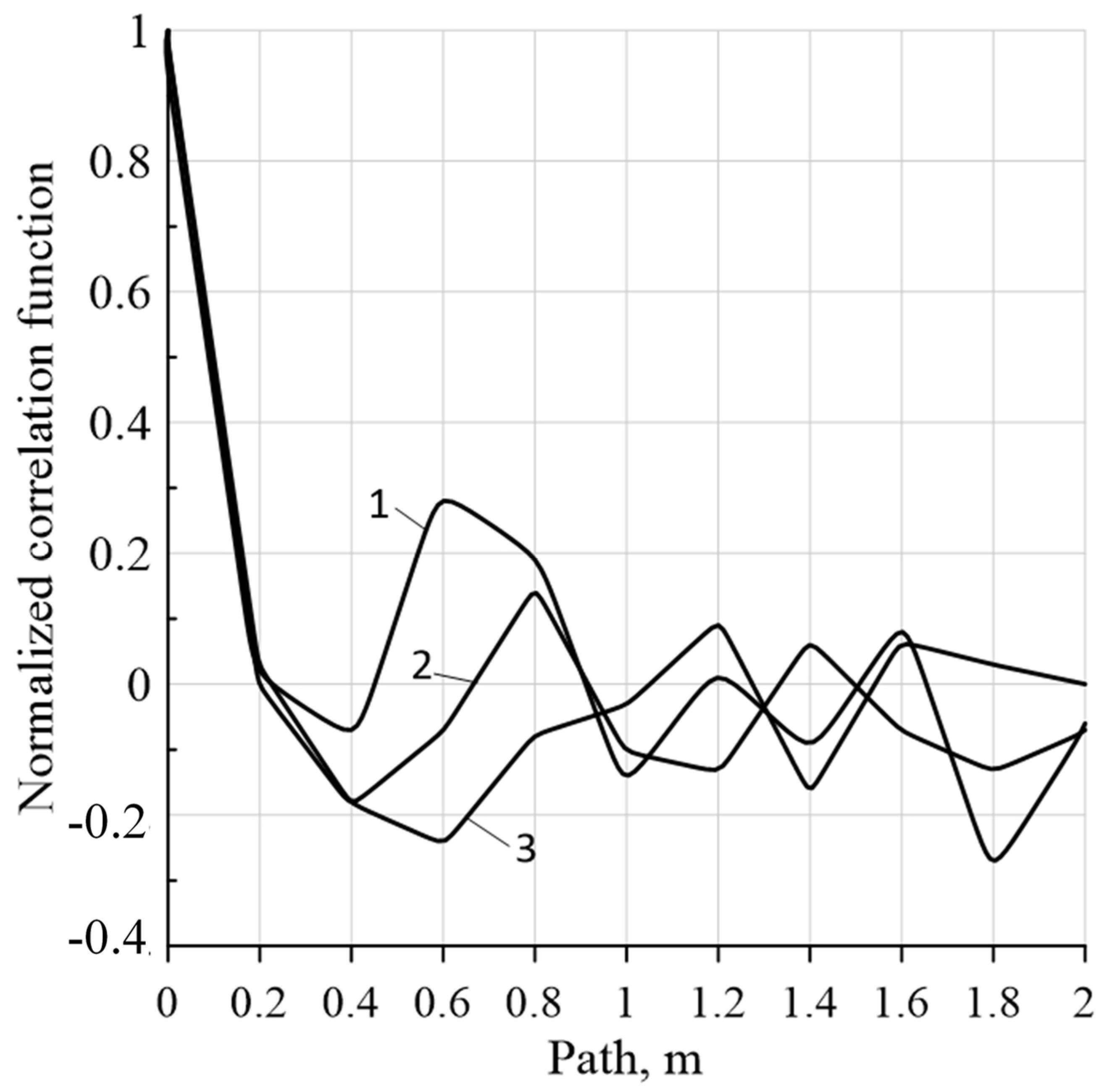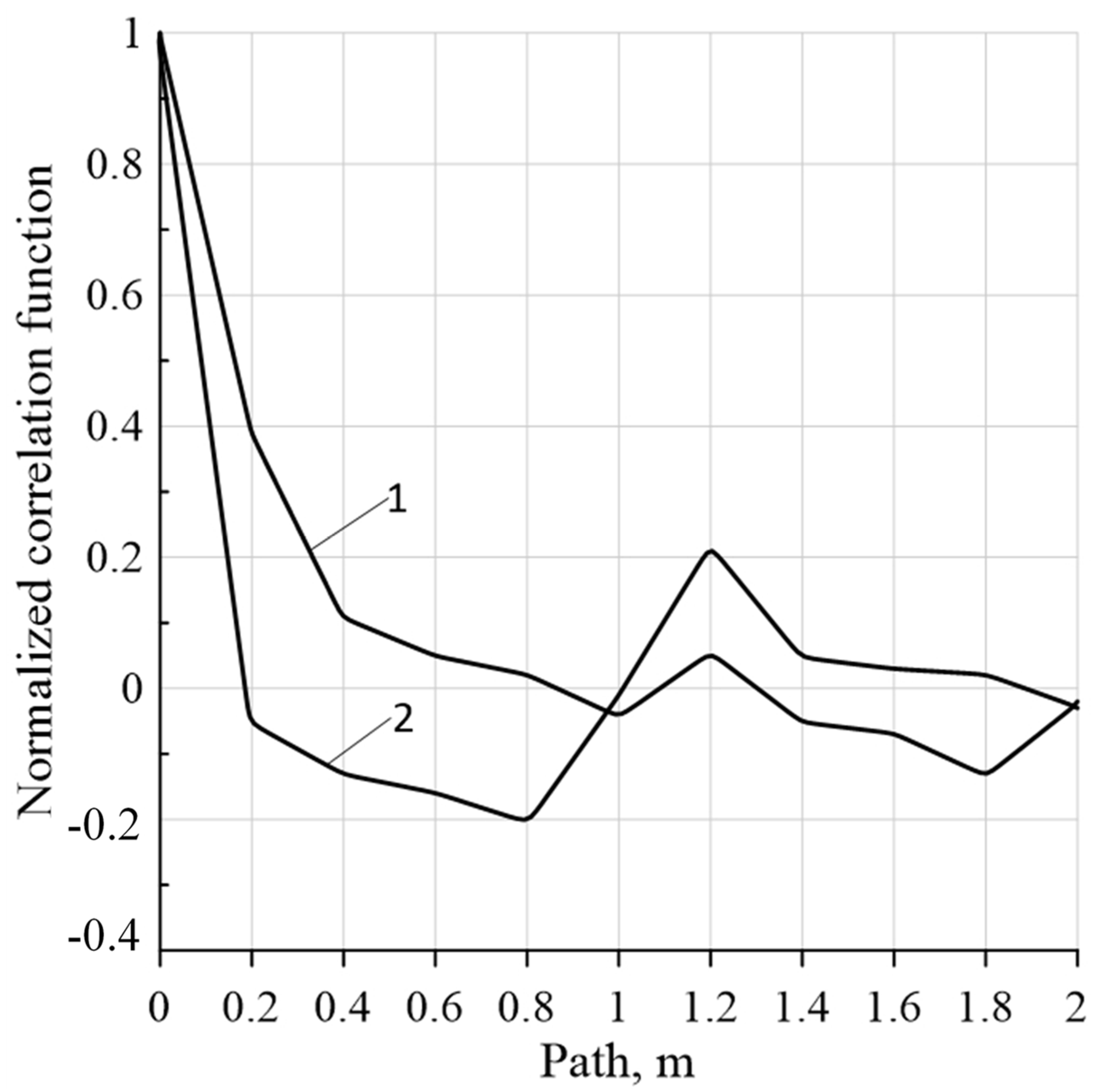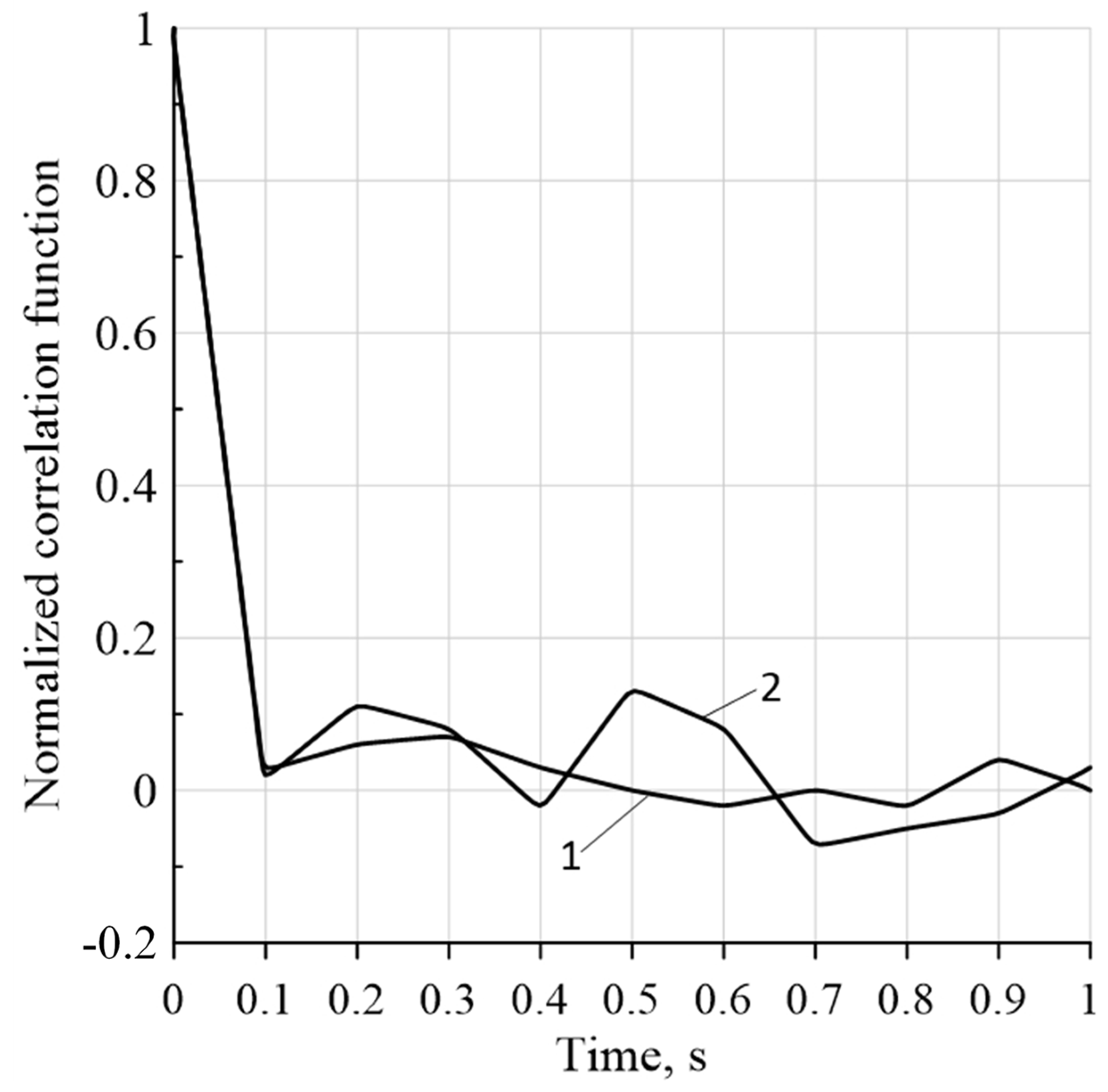1. Introduction
For productive growth and development of agricultural crops, it is necessary to create appropriate soil conditions determined by proper density, hardness, porosity, humidity, etc. The soil is thus subjected to appropriate treatment in the form of mechanical force applied to it by working bodies of various machines and cultivation tools [
1,
2,
3].
Until recently, plowing was the most common method of such processing. According to DSTU 4691:2006 “General agriculture. Terms and definitions”, “plowing is a method of mouldboard tillage with a plow which provides crushing, loosening, and turning a soil layer by at least 135°.” The additional purpose of plowing results from the need to create a background for sowing, which—as the authors believe—is not always the case. The definition of plowing has evolved over the years. There is a need to look at the scientific basis and rationale for plowing as a tool for seedbed preparation, which is the subject of consideration in many scientific publications [
4,
5,
6].
Stubble cultivation immediately after harvesting is a standard procedure performed on most farms, both with classic cultivation technology based on annual ploughing and by those farmers who have abandoned it. It is a phenomenon of sorts, as previously this procedure was carried out on a large scale with sub-plows, which are hard to see in widespread use, while the further step of eliminating the plows from cultivation operations altogether has been taken by only a minority of farms. Plowing has many advantages, which are indisputable when it comes to, for example, reducing the number of various agrophages by mechanically destroying them. However, it should be stressed that this treatment leads to an acceleration of mineralisation. This phenomenon can be explained by the principle of the kiln, to which wood is added. Each stirring of the logs causes an increase in the flame due to the increased access of oxygen. Similar processes are intensified by the traditional cultivation system.
Although the plow is not technically a soil preparation tool, the more even the field background after plowing, the better the soil preparation for sowing—it is hard to argue with that. This is especially important in the adjacent passages of the plowing unit. In practice, there are many cases when poor-quality plowing requires high costs for leveling the background of the field.
In addition, DSTU 4691:2006 points out that, in the case of a plow with skimmers, plowing is called ‘cultural’ [
7]. It follows that ordinary plowing is or can be done with a plow without skimmers. However, according to the world-famous soil scientist V.R. Williams, such a constructive version of the tillage working device is only possible when the manure scattered onto the field is mixed into the soil [
8]. In other cases, plowing must be carried out with a plow that must be equipped with skimmers. Academician W.R. Williams is correct in saying that the skimmers should only be removed when the manure is incorporated; it should be placed in the entire arable layer and not just at the bottom of the furrow, which happens in the skimmer’s presence.
Currently known definitions of the technological purpose of the skimmer were analyzed and its disadvantages were considered. For example, the classic agricultural literature emphasizes that this work team must cut the topsoil to a depth of 12 cm, turn it over, and lay it on the bottom of the furrow [
9] to ensure deep incorporation of weeds [
10] and crop residues. Other scientists argue [
11] that the skimmer is mainly designed to drive the top layer of turf into the soil.
It was noted in the paper that a skimmer is required to reduce the loosening of the plowed soil layer [
12]. At the same time, it is emphasized that this working body performs a blocked cut of the soil whereby the force needed to perform such a process increases 3–5 times. Finally, it is concluded that the skimmer does contribute to an undesirable increase in the pressing force of the plow against the furrow wall. This obviously [
13] leads to an increase in the traction resistance of the entire cultivation unit.
The analysis of the above raises a number of questions to which it would be problematic to find unambiguous answers.
Firstly, how to treat plowing with skimmers in the absence of salinity of the topsoil? Plowing is the main method of cultivation. In this case, the soil layer is rotated and loosened to a depth: shallow plowing, 6–12 cm; medium plowing, seed plowing, 16–22 cm; deep plowing, winter plowing, 25–30 cm; very deep plowing, 35–80 cm. Very deep plowing is used on sufficiently dense soils, e.g., for planting hop and vine plantations, and in hot climates for storing rainwater. Usually plowing is undertaken with a plow equipped with a skimmer. The skimmer is able to cut only the top layer of soil about 10–12 cm thick. Soil salinity may be caused by the natural accumulation of salt in the soil or by improper human activity leading to the formation of salty soils. Fertilizers that remain in the topsoil may over time lead to excessive salinity of the soil, as well as to its acidification.
Secondly, the occurrence of lumps during the main crop cultivation confirms its unsatisfactory structure. Of course, this happens due to repetitive annual plowing with a plow without skimmers in the previous period. Well-structured soil is cultivated without clumping, therefore, their presence in modern practice does not mean that the prevention of agricultural subsoil lumping was a prerequisite for the invention and use of such a tillage working device as skimmers.
Soil with a normal structure does not form a lump when processed. Therefore, the clodiness of the soil is both a consequence of its compaction and a result of the loss of structure due to systematic plowing without skimmers.
Thirdly, the statement that this tillage working device performs a blocked cut of the soil is a hypothesis rather than a postulate. If for no other reason, the main deforming action of the skimmer on the soil layer is not cutting the soil, but its separation from the main mass [
14], as will be emphasized below. Further, the energy consumption for its implementation is much lower than that of cutting or moving the soil [
15].
Fourthly, the skimmer makes a certain (a priori rather insignificant) contribution to the process of pressing the plow against the furrow wall. However, in doing so, it respectively reduces the analogous effect of the main body of the plow. After all, the latter simultaneously deforms the soil layer whose height is already smaller than the depth of the skimmer.
In comparison with the above interpretations, the most evidential position on the establishment of this cultivation authority is contained in the paper. According to the scientifically substantiated statement of V.R Williams, the skimmer is designed to replace the 8–10 centimeter-deep top layer of damaged soil with its lower, more structured layer [
8]. Moreover, these layers do not need to be additionally loosened, crushed, turned over, or, especially, moved to the side.
Therefore, in the authors’ opinion, plowing with a plow with obligatory skimmers should be conducted not annually or even periodically, but regularly. An indicator of such regularity should be the value of the coefficient of the upper structure (8–10 cm) of the soil layer, which does not exceed 0.67 [
16].
This coefficient, denoted by k, is defined as follows:
where M
av—mass of agronomically valuable soil particles with a diameter of 0.1–10 mm; M
na—mass of soil particles with a diameter of less than 0.1 mm and more than 10 mm.
Otherwise, the problems related to loosening or crumbling the soil, clogging of agricultural equipment, etc., should not be solved by plowing, but by other technological methods.
In the authors’ opinion, of all the reasons for the refusal to use skimmers, only one of them is the most significant. Its essence lies in the fact that, according to many practitioners and even some scientists, the use of these tillage working devices leads to an increase in the traction resistance of the plow [
12,
17,
18,
19]. At the same time, the data that they obtained cannot be considered as absolutely accurate and reliable. In many cases, these results can only be considered as statements of fact, the pattern of manifestation of which does not contain any convincing evidence, and therefore requires further consideration and careful analysis.
As it turned out, despite the conservatism of the plow design, the interplay of the plowshare and the plowshare of its body with the skimmer is currently very little researched. The main attention in this issue was focused only on the study of the “plowshare with mouldboard—soil” system [
20,
21]. At the same time, if the skimmers played the role of a physical object of research, it was only towards solving the problem of reducing the pollution of the cultivation equipment [
22]. Further, the two-level plow was considered as a compromise option. The first attempts to justify the design parameters of the working surface of the skimmer were made in the last century [
23]. It was noted by the author of this paper that the use of skimmers increases plow traction resistance by 5–8%, however the internal nature of this fact was not taken into account, and the indicated regularity was by no means confirmed.
The paper [
19] also presents the results of research on the influence of skimmers on plow traction resistance. However, this study was conducted not by direct measurement, but by theoretical calculations using discrete modelling methods. It was with their help that the authors [
17] conducted quite extensive research that aimed at determining the impact of the angles of the working surface of the skimmer on the quality of rotation and movement of the soil medium through it. It is interesting that the depth of tillage with this working body, as in the case of [
19], was adjusted in the range of 5–10 cm. An interesting question remains: what is the reason for the need to study the working process of the skimmer at a stroke depth of less than 8 cm? At the same time, it remains unanswered, because in [
17,
19] it is not stated or supported by evidence. In addition, the question of the influence of skimmers on shaping the cross profile of the plowed field surface remains open. Of course, this factor also requires further careful study as it is very important to ensure further high-quality processing of the plowed agricultural background.
Research Objective: to determine the impact of skimmers mounted on the plows of cultivating and tractor units on their energy and technological parameters, particularly on traction resistance and the cross profile of the plowed field surface.
2. Materials and Methods
To achieve this goal, theoretical and experimental research methods were used.
In the first of these stages, skimmers’ influence on the plow’s technological properties is investigated: the uniformity of the plowing depth, the working width, and the evenness of the plowed field. In the first stage of field research, a plow with skimmers is compared with a plow equipped with skimmers and a double-deck plow. The latter, as you know, can be considered a plow with skimmers, which are non-removable and have the same design parameters as the main bodies. At this stage of field research, as clearly follows from the presented results, a comparative assessment of the effect of skimmers on the technological performance of the plow is given: the uniformity of the depth and width of the grip and fluctuations in the profile of the plowed background.
To evaluate the effect of skimmers on the traction resistance of the plow and, at the same time, on its technological performance, two versions of the same plow are needed: one version has skimmers, but not the other. Otherwise, the results of the studies would be incomparable. This problem was solved in the second stage of field research.
In the second stage, in addition to evaluating the technological properties of the arable unit, information is added on the skimmers’ effect on the plow’s traction resistance. The results of both stages found their place in the article’s conclusions.
The theoretical research was therefore conducted using the basic provisions of the theory of agricultural machinery, theoretical mechanics, and higher mathematics. A PC computer with the Mathcad 15.0 software environment was used to calculate the analytical relationships obtained. The graphical interpretation of the calculations obtained was carried out using the Grapher 20 editor. Standard methods were used during field experiments in real plowing conditions. The processing of the obtained experimental data was carried out using statistical methods on a PC using the Statistics program.
The conducted field experimental studies included two series of experiments, each of which was carried out twice. The physical objects of the tests in the first series were plow units seated on a wheeled tillage tractor of traction class 3, KhTZ-16131 brand. Its technical parameters are presented in
Table 1.
The tractor was aggregated alternately with plows whose technical parameters are presented in
Table 2. These tools were set to a plowing depth of 25 cm.
During the experimental field tests, the cultivation depth, working width, speed, and cross profile of the plowed field surface were recorded for each tractor-cultivation unit combination.
A set of recording and measuring equipment was used for this purpose, which is shown in
Figure 1. The technique of using this equipment was successfully tested and described in [
26,
27,
28].
The physical objects of the second series of the field experiments were two tractor-cultivation units seated on a class 3 tractor KhTZ-16131. The first one included a PLN 5-35 plow equipped with skimmers and a device for recording the traction resistance of the cultivation tool (
Figure 2). The second test tractor-cultivation unit included the same plow, but with remote skimmers.
Prior to the field experiments, the moisture content (
Figure 1d) and density (
Figure 1c) of the initial agrotechnical substrate were measured using appropriate instruments, in accordance with the method described in [
26,
27,
28].
The traction resistance of the plow was measured using a conventional tensometric link 3, which was installed on the plow in a unique frame 2 (
Figure 2).
The tensometric link is a steel ring with four foil resistances glued on its inner surface, according to the scheme of the world-famous Wheatstone bridge. On the one hand, this ring is attached to the plow frame, and on the other hand, to strain gauge frame 2, which is movable relative to the plow frame. When the tensometric link is stretched by the traction resistance of the plow, an electrical signal arises in it, transmitted to an analogue-to-digital converter connected to a computer. The latter, using software, digitizes the incoming electrical signal and saves the digital data in a separate file. Subsequently, these data are used to calculate the required statistical characteristics of the plow’s traction resistance.
Finally, since this technique is known to the entire scientific world, the authors of the article limited themselves to indicating that they measured the traction resistance of the plow using a strain gauge link. We add that the error of the measuring circuit does not exceed 1%.
Moreover, in this case, the error in measuring the traction resistance of the plow is not very important. The article is not about the absolute but the relative assessment of this indicator for various plow options. Therefore, if there is a system error, it is present in all compared plow options and therefore does not affect the comparative assessment.
As for fuel consumption, we did not record its consumption; therefore, there are no data regarding it in the article.
Based on the obtained experimental data calculated by statistical methods using a PC, the following statistical characteristics of the studied parameters were analysed: mean values and their least significant difference (LSD05), variances, standard deviations (standards), coefficients of variation, and normalized correlation functions.
3. Results and Discussion
In order to carry out theoretical research, a diagram of the interaction forces of the skimmer with the soil layer was built, as shown in
Figure 3.
The authors of the paper believe that, in the process of working movement and interaction with the soil mass on the skimmer with the angle β on crushing, the following external forces act: F—total resistance of the soil layer to deformations and G—the weight of the soil layer.
The reaction R that occurs simultaneously on the working surface of the skimmer moves a layer of soil with a thickness a, raising it to a height h.
Let us present the reaction R in the form of two components. The vertical component R
y of the force R is the response to the weight force G of the soil layer. The horizontal component R
x, which actually overcomes the resistance of the soil environment F, is essentially the traction resistance of the skimmer. According to [
8], the force R
x can be found from the following expression:
where ρ is the soil density, kg·m
−3; b is the width of the deformable soil layer, m; φ is the angle of soil friction (in degrees); g is the gravitational acceleration, 9.81 m·s
−2.
Soil compaction in the field can be controlled; although it is very problematic, it is possible. Nevertheless, since the density of the soil is included in the formula (2), it is measured in the field and used in theoretical calculations.
If we assume in this expression (2) the following notation:
Then the expression (2) will have the following form:
The analysis of the obtained relationship (4) shows that, with the decrease in the values of parameters a, b, h, and ρ, the value of the traction resistance of the skimmer R
x also decreases, and vice versa. With regard to the coefficient k, this cannot be unequivocally stated because each value of the angle of soil friction φ corresponds to such a value of the crushing angle β of the skimmer at which the value of the coefficient k is optimal, i.e., the lowest in this case [
8].
With this in mind, it is enough to analyse the relationship (3), i.e., to explain the nature of the relationship .
Graphs were constructed using a PC that present the dependence of the coefficient k on the crushing angle β of the skimmer at different values of the angle of soil friction φ (
Figure 4). The graphical interpretation of this dependency indicates that, with the increase in the angle β of soil grinding by the skimmer to a certain value, the value of the coefficient k decreases, regardless of the angle of soil friction φ. Further, for larger values of the latter, the steepness of the decrease (or increase) of
is more intense.
The values of the angle β (β
opt), at which the value of the coefficient k is the smallest, can be found by taking the first derivative of expression (3). As a result, we will have as follows:
Numerical PC calculations of the expression (5) showed that the ground friction angles φ equal to 20, 30 and 40° correspond to the values βopt equal to 27, 25 and 22°, respectively.
With this in mind, a formula is obtained, according to which, with the increase in the value of the crushing angle β to the level of βopt, a decrease in the value of the βopt coefficient should be expected, and thus a decrease in the traction of the skimmer resistance.
Conversely, the use of this cultivation set with a grinding angle greater than the βopt level will result in the opposite, and therefore in an undesirable effect. Moreover, this will occur at any permissible value of the ground friction angle φ.
In the process of conducting experimental research, skimmers with a grinding angle of β = 25° were used. The values of the φ parameter were not determined in this case. At the same time, with sufficiently low soil moisture at the level of 12.5% in the 0–30 cm layer and density of 1.3 g·cm−3, it is highly probable that the value of the φ angle is close to the level of 40–45°.
With the same plowing depth set to 25 cm, the lowest working speed of movement (2.08 m·s
−1) was that of the agricultural tractor with the largest working width, and the highest speed of movement (2.25 m·s
−1) was that of the machine with the smallest working width, which is a completely logical result. The efficiency indices obtained for cultivating and tractor units equipped with various plows are presented in
Table 3.
The dispersion of plowing depth fluctuations of experimental tractor-cultivation units was compared, according to the Cochran criterion [
29]. According to the field measurements (
Table 3), the actual value of this indicator is G
f = 0.37, and the tabular value G
t = 0.43. Since in this case G
f < G
t, the null hypothesis about the equality of the compared dispersion of plowing depth fluctuations in the compared plows at the statistical significance level of 0.05 is not rejected.
According to agrotechnical requirements, when operating an arable unit, it is important that the plowing is “continuous”. This is so that the paths of each plow body are not noticeable, and the junction of adjacent paths of the arable unit is also not noticeable. When working without skimmers, this is entirely possible. That is why we evaluated the transverse profile of the plowed field.
According to the one-way analysis of variance, the actual value of Fisher’s F criterion (F
f = 5.19) for the compared average plowing depths with three plows turned out to be greater than the tabular value (F
t = 3.03). This means that the null hypothesis that these statistical indicators belong to the same general sample is rejected. According to the indicator LSD05 = 0.31 (
Table 3), it is no coincidence that the average depth of plowing with the PNB-5-40 plow is greater than for the other PLN-5-35 and PNJA-4-42 plows. At the same time, it is problematic to establish the correctness of this fact. The probable reason for its occurrence is the inaccuracy of setting the specified plowing depth on the plow PNB-5-40 at the level of 25 cm.
When comparing the dispersion of fluctuations in the working width of the compared plowing units, the actual value of the Cochran criterion is Gf = 0.39, and the tabular value Gt = 0.46. Since Gf < Gt, the null hypothesis about the equality of the compared dispersion of plowing depth fluctuations in the compared plows at the statistical significance level of 0.05 is not rejected. In practice, this means that, at different working widths of the three agricultural tractors, the values of the variations of this operating parameter do not differ from each other; they represent the same general population with 95% certainty.
When assessing the statistical characteristics of the cross-profile of the field surface after plowing, the actual value of the Cochran criterion is Gf = 0.47, and the tabular Gt = 0.42. Since in this case Gf > Gt, the null hypothesis about the equality of the compared variances at the statistical significance level of 0.05 is rejected.
The obtained statistical characteristics are heterogeneous. In this case, the following regularities were found. The dispersion of field surface profile fluctuations after plowing with PLN-5-35 and PNJA-4-42 plows are homogeneous. According to the actual value of Fisher’s F-test (Ff = 1.17), which is less than its tabular value (Ft = 1.60), both of these statistical characteristics represent the same general population.
The dispersion of fluctuations in the field surface profile after the passage of an agricultural unit equipped with the PNB-5-40 plow (6.8 cm2) is much greater than in the case of the other two plows. This result is supported by a comparison of actual and tabular values
Fisher’s F criterion. Namely, for the pair of plows PNB-5-40 and PLN 5-35: Ff = 1.66 > Ft = 1.60. For the plow pair PNB-5-40 and PNYJA-4-42, the difference is even greater: Ff = 1.86 > Ft = 1.60. Hence the conclusion that the use of a plow with skimmers instead of skimmers alone leads to an undesirable increase in the oscillation amplitude of the cross profile of the surface of the cultivated (plowed) field.
Now, regarding the intrinsic (frequency) nature of this process. The analysis of normalized correlation functions shows that the correlation (abscissa of the intersection of curves 1, 2, and 3 of the zero mark) between the ordinates of the field profile after each of the three cultivating machine-tractor units has passed, disappears quite quickly, after 0.2 m (
Figure 4).
The normalized correlation function, as is known, reveals the internal (that is, frequency) nature of the process under study. It happens that the same average values and the same variances characterize two processes. However, at the same time, they turn out to be completely different since their oscillations differ in frequency. The correlation function is called upon to establish this difference.
The oscillatory nature of processes 2 and 3 is approximately the same. Both contain hidden periodic components whose generators are rather problematic to determine. Most likely, they result from the uneven structure of the cultivated soil environment.
The normalized correlation function of the fluctuations of the ordinates of the field surface profile after plowing with the PND-5-40 plow (curve 1,
Figure 5) is characterized by the presence of a more distinct periodic component. Moreover, both in terms of amplitude (which is confirmed by the above dispersion analysis) and period whose generator is also quite difficult to detect, it cannot be ruled out that the skimmers mounted on the PND-5-40 plow instead of standalone skimmers played a role in this.
The research of the influence of skimmers on the traction resistance of the PLN-5-35 plow showed the following: the average value of the plowing depth using the tool with skimmers turned out to be greater than in the variant without them. Despite the small value of the obtained difference (0.8 cm), it is statistically significant, as it exceeds LSD05 = 0.6 cm (
Table 4). At the same time, the experimental data obtained are not sufficient to consider this fact natural. In order to finally confirm this regularity and explain its nature, it is necessary to conduct a series of special experiments.
The difference between the dispersion of plowing depth fluctuations with the PLN-5-35 plow with and without skimmers is also significant. According to the Fisher’s F-criterion, its actual value Ff = 1.45 is greater than the tabular Ft = 1.39. It follows that the use of skimmers provides a smaller dispersion of plowing depth fluctuations compared to the option without these main bodies.
The explanation of this result is as follows. According to their purpose, the skimmers move the damaged layer of soil to the bottom of the furrow. At the same time, the main bodies of the plow move the lower layer of the soil in place of the upper one. Due to its structure, this layer contains practically no soil lumps (soil aggregates with a diameter of more than 1 cm). Most agriculturally valuable soil aggregates on the surface of the field cause a significant reduction in the dispersion of fluctuations in its cross profile. This process, by its nature, is not very variable [
29] because the value of the variation coefficient of plowing depth fluctuations with the PLN-5-35 plow with skimmers does not exceed 10% (
Table 4). Soil clods with a diameter of 1 mm are not formed as a result of the skimmer action on the soil; they are created due to the humification of the soil in those anaerobic conditions in which it falls under the influence of the skimmer. Without a skimmer, the soil’s upper unstructured and lower structural layers simply mix. Ultimately, lumps larger than 1 cm are formed during subsequent ploughing.
As results from the analysis of the data contained in
Table 4, the null hypothesis about the equality of average values of the PLN-5-35plow width with and without skimmers is not rejected. The actual difference of this parameter is 0.01 m, which is five times less than the LSD05, i.e., 0.05 m.
The situation is similar with the dispersion of fluctuations in the working width of the compared cultivation units because the actual value of the Fisher’s F-criterion (F
f = 1.06) is much smaller than the tabular F
t = 1.86. In principle, the obtained result is logical because the correct installation of skimmers on the plow does not create (and should not create) premises to change its width. A smaller dispersion of plowing depth fluctuations with a plow with skimmers is a direct premise for shaping a better cross profile of the field. In this case, the dispersion of the parameter itself (6.48 cm
2,
Table 4) is much smaller than the spread (19.60 cm
2) of the dispersion of the field profile after its treatment with the same plow with remote skimmers.
The null hypothesis that these variances belong to the same general sample is unequivocally rejected because the actual value of the Fisher’s F-test (Ff = 3.0) is much larger than the tabular value (Ft = 1.39). This null hypothesis is also confirmed at a significance level of 0.01, as in this case the tabular value of the Fisher’s F test is 1.59.
If the dispersion represents the amplitude of oscillations of the field profile ordinates, then the correlation function is their frequency (periodicity) [
30]. The analysis of these characteristics shows that the fluctuations of the cross-field profile after the passage of the PLN-5-35 plow with skimmers (curve 1,
Figure 6) are of a lower frequency (more even) compared to the profile fluctuations that are generated by the same plow without skimmers (curve 2,
Figure 6).
This is evidenced by the different values of the correlation lengths of the compared normalized correlation functions. Thus, for curve 1, as an expression of a lower frequency process, this length is almost 0.9 m, while for curve 2, this figure does not exceed 0.2 m. Moreover, the fluctuation nature of the normalized correlation function 2 indicates the presence of a component with a period of about 1.7 m.—and this practically coincides with the plow width of the PLN-5-35 plow with remote skimmers (1.77 m,
Table 4).
As shown by experimental data, the lack of these working bodies does not lead to an increase in the traction resistance of the plow, which is presented in [
10,
14]. On the contrary, its average value decreases by 1.1 kN (
Table 4); this result is statistically significant because it is greater than LSD05 = 0.27 kN.
In addition, the decrease in traction resistance of a plow with skimmers is, in our opinion, a natural phenomenon. Let us consider it in more detail. From the point of view of the impact on the soil, the skimmer works identically to the triangular wedge. As emphasized in [
13,
16], if β + φ > 90°, the wedge pressure on the ground acts horizontally. In this case, the soil environment is constantly subjected to shearing deformation.
For the skimmers that were used in our experimental research, the value of the grinding angle was β = 25°. Even assuming the maximum value of the ground friction angle at 45°, we obtain the result that β + φ = 70° < 90°. In such conditions, the impact force of the wedge on the ground deviates from the horizontal position upwards by the angle of [90 − (β + φ)] (see
Figure 3).
This causes deformation of the soil environment not by shearing, but by separation, which requires less energy to implement [
16]. As a result, it is this fact that is the basis for the regularity, according to which properly selected and installed skimmers naturally contribute to reducing the traction resistance of the plow. At worst, they do not increase it.
The distributions of fluctuations in the traction resistance of the plow with skimmers and without are homogeneous (
Table 4). This is confirmed by the fact that, according to the Fisher’s F-test, the null hypothesis of their equality at the statistical significance level of 0.05 is not rejected. According to experimental studies, the actual value of this indicator F
f = 1.29 is less than the tabulated F
t = 1.39. The internal character (periodic nature) of the fluctuations of the traction resistance of the plow with and without skimmers is also practically homogeneous. This statement can be confirmed by the course of normalized correlation functions of this process (
Figure 7).
As can be seen from the analysis of
Figure 7, curve 2 shows a process with a slightly higher frequency than curve 1. At the same time, for sufficiently small values of the variance of the plow traction resistance fluctuations and their insignificant difference, the difference in character of the course of the compared normalized correlation functions can be neglected. This statement is supported by the appropriate values of correlation coefficients (
Table 4), the level of which does not exceed 6%.
As a result, the above analysis clearly shows that the use of skimmers allows to reduce the spread and frequency of vibrations of the transverse profile of the plowed field surface, while reducing the traction resistance of the plow. Considering the role of these working bodies in the preservation and restoration of the soil structure, one must agree with the basic requirement of systematic plowing with a plow with skimmers necessarily installed.
